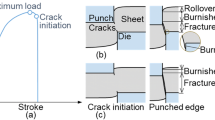Conclusions
The above method seems to be the most promising at the present time, since it is free of the drawbacks characteristic of the Brinell and Rockwell methods (and hence, also, of instruments types TSh and TK), it lends itself to complete automation of hardness measurements, and to the provision for the hardness-measuring instruments of a recording chart in coordinates of load versus deformation.
Similar content being viewed by others
Literature cited
R. G. Batson, N.P.L. Report for 1931.
O'Neill, Hardness of Metals and Its Measurement [Russian translation] (1940).
Fertigungstechnik und Betrieb. Probleme der Härtemessung, 2/59, 2 (1959).
Rights and permissions
About this article
Cite this article
Ulegin, V.G. Hardness testing in automatic and conveyor lines. Meas Tech 6, 743–745 (1963). https://doi.org/10.1007/BF01419346
Issue Date:
DOI: https://doi.org/10.1007/BF01419346




